Winter Wetsuit Thickness: Essential Guide for Kiteboarding
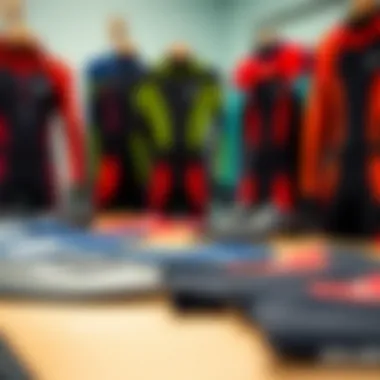
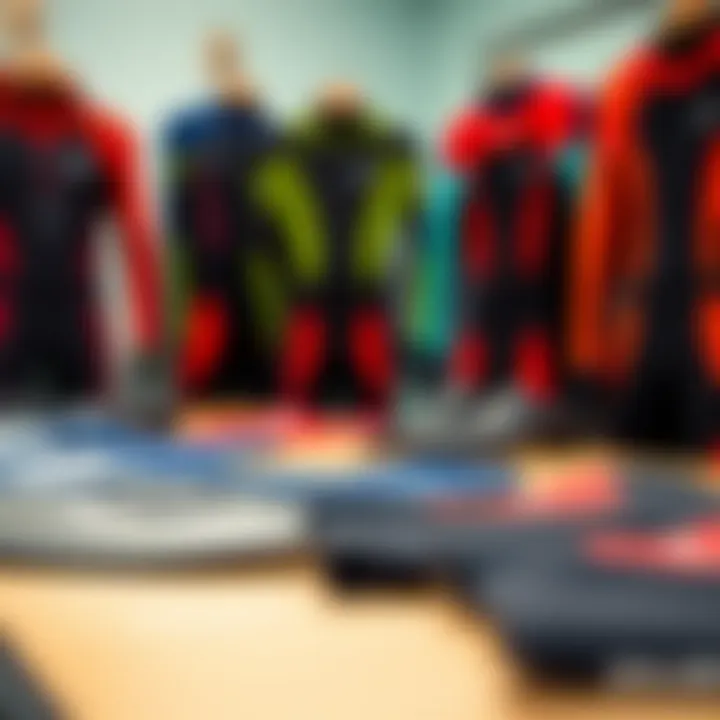
Intro
When it comes to kiteboarding in the chilly embrace of winter, the right winter wetsuit can be the difference between a thrilling ride and an involuntary swim back to shore in search of warmth. Understanding the thickness of wetsuits is essential, as it directly impacts your comfort, performance, and safety. This guide seeks to delve into the different thickness options available, analyze how materials affect thermal retention, and discuss factors like fit and durability.
A wetsuit's thickness is typically defined in millimeters, commonly ranging from 2/2mm for those crisp fall days to 6/5mm for deep winter conditions. It’s crucial to grasp how these measurements relate to the water temperatures encountered by kiteboarders. Anyone who has experienced the plunge into frigid water knows that water steals body heat faster than a thief in the night.
Moreover, kiteboarding isn't just about surviving the cold; it’s about enhancing your experience on the water. A well-chosen wetsuit not only keeps you warm but also allows for the flexibility and movement necessary to perform and progress in the sport. So, what should you look for when choosing your winter wetsuit? Let’s take a closer look.
Gear Selection
When it comes to kiteboarding gear, two primary components require your attention: kites and boards. Both of these elements play crucial roles, but they are often secondary to the foundation that a good wetsuit provides.
Types of Kites
Kites come in various shapes and sizes, each suited to different wind conditions and riding styles. For beginners, a stable and forgiving kite like the North Reach is typically recommended. On the flip side, more experienced kiteboarders might lean towards a more agile model like the Slingshot Rally that shines in dynamic conditions. Understanding your needs, along with those of the environment, is key to maximizing your kiteboarding experience, especially in colder weather.
Choosing the Right Board
Similarly, selecting the right board can drastically improve your time on the water. A directional board might suit some riders, providing control in choppy waters, whereas others may prefer the versatility of a twin-tip board. The board choice often intertwines with the wetsuit size and fit because a good balance of buoyancy and control will help keep you riding longer, even as temperatures plummet.
The right gear doesn’t just help you survive; it enriches your entire riding experience.
While some might focus solely on thickness when it comes to wetsuits, it's worth noting materials and cuts come into play too. Neoprene thickness is only part of the equation; how that material is crafted can make a significant impact on flexibility and comfort.
As we continue our journey through this guide, we will unpack the layers of considerations surrounding wetsuit thickness, materials, fit, and durability. This will not only arm you with the knowledge to select the best winter wetsuit but also ensure your kiteboarding adventures are both comfortable and effective, no matter the conditions.
Stay tuned as we dive deeper into additional factors that influence your choice and the overall kiteboarding experience.
The Importance of Wetsuit Thickness
Choosing the right wetsuit thickness is akin to selecting the right armor for a knight about to head into battle. It may seem like a minor detail, yet it plays a pivotal role in the comfort and performance of kiteboarders braving the chill of winter waters. The thickness of a wetsuit directly influences how well it retains body heat, facilitates movement, and ultimately, enhances the overall experience on the water.
When kiteboarding during colder months, exposure to frigid temperatures can quickly lead to discomfort or even hypothermia. Thicker suits generally provide more insulation, which is crucial for maintaining core body temperature. But it’s not just about heat retention; a well-chosen wetsuit also ensures agility and flexibility, allowing for optimal performance.
Riding through the wind and waves while feeling warm and secure can make the difference between an exhilarating ride and an uncomfortable ordeal. So, it’s essential to understand various thickness options available and their respective benefits. Moreover, one must consider not only the material used but also how that thickness translates into actual performance in diverse environmental conditions.
"A wetsuit is not just about warmth, it’s about feeling the freedom to conquer the waves without fear of the cold."
In essence, understanding wetsuit thickness becomes not merely a matter of choice, but a vital aspect of kiteboarding safety and enjoyment. This guide will explore the intricacies involved in selecting the perfect wetsuit, delving into thermal regulation, the impact on performance, and other significant factors that directly relate to the thickness of the suit.
Understanding Thermal Regulation
The body naturally generates heat, but when submerged in cold water, heat loss can occur rapidly, leading to a chilling effect. The thickness of the wetsuit acts as a barrier against this heat loss. Generally, the thicker the suit, the more it insulates against the cold.
Many wetsuits have thickness specifications like 3/2mm or 4/3mm, which indicate the millimeters of thickness across the chest and limbs. A suit with a thickness, say 4mm in vital areas, provides plush insulation, while leaving areas that require flexibility—like the arms and legs—thinner at 3mm. This not only helps to keep the body warm but also allows for free movement.
Here are some factors that influence how well a wetsuit regulates thermal comfort:
- Material Quality: Neoprene, the primary material used in wetsuits, can vary significantly in quality. Better-quality neoprene retains heat better and provides durability.
- Design Features: Bells and whistles like seals around the neck, wrist, and ankles help prevent water from flooding in, enhancing thermal retention.
- Water Temperature: Environmental conditions are critical. A suit that is just right for one temperature may be inadequate for another.
Ultimately, managing thermal regulation through proper wetsuit thickness is essential for any kiteboarder looking to push the limits during the winter months.
Impact on Performance
The connection between wetsuit thickness and performance might not be blatantly obvious, but it's crucial. A thick wetsuit offers insulation, but too much thickness might hinder agility and responsiveness. This can be especially detrimental for kiteboarding, where quick reflexes and fluid movements are key to navigating gusty winds and choppy waves.
Kiteboarders often trade comfort for performance, putting themselves at risk of losing mobility by opting for thicker suits than necessary. Here are some considerations:
- Flexibility vs. Warmth: A thicker wetsuit can mean reduced flexibility, especially in arm and leg movements. This can impact tricks, jumps, and turns when kiteboarding, as the suit may restrict natural motions.
- Timing of Gear: For warmer days or if engaging in brief sessions, a thinner wetsuit might actually yield better performance than a thicker one that might leave you sweltering in the sun.
- Strain on Musculature: Heavy wetsuits can lead to fatigue faster. The more cumbersome the suit, the more effort required to maintain dynamic movements, ultimately affecting overall endurance.
Standard Wetsuit Thickness Options
Choosing the right wetsuit thickness can make all the difference when it comes to maintaining warmth and performance during your kiteboarding adventures in colder waters. The standard thickness options available are not merely suggestions; they are tailored to specific conditions and personal comfort levels. Understanding these options enables you to make informed choices, leading to a more enjoyable and productive experience on the water.


Short Suits: Ideal for Mild Conditions
Short suits, generally characterized by short sleeves and short legs, are perfect for those chilly but not frigid days when you just need a little extra insulation. Typically, these suits range from 2mm to 3mm in thickness, allowing for a balanced warmth while providing ample flexibility. They work remarkably well in spring and fall when temperatures can be unpredictable, yet aren't outright freezing.
- Breathability: These suits are often made with materials that allow for decent circulation of air, helping to prevent overheating during those moderate weather conditions.
- Flexibility: The thinner build means that movements remain unrestricted, allowing kiteboarders to perform tricks and maneuvers without feeling weighed down.
Ultimately, if you plan on riding in milder waters, a short suit provides a nice compromise between comfort and warmth, ensuring you stay agile without getting chilly.
/2mm Wetsuits: Versatile Choice
The 3/2mm wetsuit, often regarded as the go-to choice for many kiteboarders, strikes an effective balance between warmth and mobility. The torso is generally 3mm thick, while the arms and legs are 2mm, offering necessary insulation where it's most needed while maintaining flexibility in your limbs. This combination proves beneficial across varying water temperatures, making it a suitable choice for both beginners and seasoned riders alike.
- Versatility: Its wide application range means you can use it from early fall through late spring.
- Layering Options: It also lends itself well to layering; you can easily add thermal layers under or over, depending on how low the temperatures dip.
- Comfort: With a snug fit and soft materials, riders often report feeling secure without sacrificing comfort.
Kiteboarders can revel in their ability to stay warm while executing sharp moves without restriction, making the 3/2mm wetsuit a reliable choice in transition seasons.
/3mm Wetsuits: Balanced Warmth and Flexibility
As temperatures drop further, the 4/3mm wetsuit starts to shine. Here, the thicker material covers more of your body, providing extra insulation that is essential for those cold winter days. This suit keeps more warmth inside while allowing for freedom of movement, but it does necessitate consideration of how long you’ll be in the water.
- Insulation: The thicker neoprene efficiently retains heat, so you can spend extended periods on the water.
- Mobility: Many brands are now incorporating flex panels and high-stretch materials, enhancing mobility as technology improves. You can expect solid performance even in the chill of winter.
- Durability: Since it endures tougher weather, you will find these wetsuits often have reinforced seams to withstand more wear and tear.
A 4/3mm wetsuit can be the perfect companion when you're gearing up for a day of challenging conditions while ensuring you leave the bitter cold behind.
/4mm and Beyond: Cold Water Specialists
For those seeking to tackle cold water head-on, wetsuits of 5mm thick or more are specifically designed to keep the chill at bay. These suits are essential gear for kiteboarders who brave icy waters and winter storms without skipping a beat.
- Maximum Warmth: The substantial thickness means that body heat is retained, allowing for longer sessions without feeling the bite of the cold.
- Features for Extremes: Many of these wetsuits come equipped with hoods, gloves, and booties, creating a full barrier against the elements.
- Advanced Materials: Innovations like lined neoprene aid in keeping the water out and reducing the wind chill effect, all while maintaining comfort.
While these suits may sacrifice a bit in flexibility compared to thinner options, the protection against freezing water is unparalleled, making them indispensable for serious kiteboarders during the harsh winter months.
Choosing the right wetsuit thickness isn't just about warmth; it's a factor that influences overall performance as well. Understanding these options allows kiteboarders to select the best suit for each unique condition they encounter on the water.
Material Considerations
When it comes to choosing a winter wetsuit, the material is a prime consideration that directly affects both warmth and flexibility. Moreover, the type of material impacts the overall performance and durability of the wetsuit, which are essential for kiteboarders who face the chilly waters. Selecting the right fabric can easily turn the tide for an enjoyable kiteboarding adventure, making this section a crucial part of understanding wetsuit thickness.
Neoprene Types and Their Insulation Properties
Neoprene is the go-to material for wetsuits, renowned for its impressive insulating properties. There are different types of neoprene, and each one offers various benefits:
- Standard Neoprene: A time-tested option, standard neoprene has good flexibility but can sometimes lack in thermal insulation, especially in extreme cold. It keeps your body warm but might not keep the chill at bay during prolonged exposure.
- Limestone Neoprene: A newer innovation, this type of neoprene is made from limestone instead of petroleum, making it more eco-friendly. It's often lighter and offers improved insulation without compromising flexibility. Many kiteboarders swear by it for all-day sessions in colder waters.
- Thermal-Fleece Neoprene: This type incorporates a fleece lining on the inside, adding another layer of warmth. It feels softer against the skin and has better heat retention properties. For those cold winter months, thermal-fleece neoprene is hard to beat.
As a kiteboarder, knowing the differences in neoprene type can help in ensuring that you choose a suit that not only fits like a glove but also protects against the elements effectively. Remember, an effective wetsuit is like a second skin that keeps the warmth close while allowing for unrestrained movement.
Innovations in Wetsuit Fabrics
Wetsuit technology hasn't stood still; in fact, recent innovations have revolutionized performance in the water. The advanced fabrics used in today's wetsuits keep pace with the demands of kiteboarding. Some noteworthy advancements include:
- Glide-skin Technology: This fabric reduces water entry significantly by creating a slick surface. The less water that enters the suit, the warmer the wearer stays!
- Aqua-taped Seams: These specially designed seams enhance waterproofing and flexibility. The seams are less likely to cause cold spots and improve the overall integrity of the suit. This is particularly beneficial for kiteboarders who push their limits in terms of duration and intensity.
- Quick-Dry Fabrics: Fabrics that dry instantly save you a good chunk of time after a long session. Quick-dry materials mean that you can be back on the water sooner rather than later.
"Materials play a pivotal role in the overall experience of kiteboarding during winter months. Investing in a high-quality wetsuit, backed by advanced material technology, can make all the difference in performance and warmth."
Fit and Comfort: Critical Factors
The significance of fit and comfort in selecting a winter wetsuit cannot be overstated. When you're out on the water, especially in colder conditions, the last thing you want is a suit that restricts movement or feels uncomfortable. Ultimately, your experience hinges on how well a wetsuit fits your body shape. A proper fit not only maintains thermal efficiency by trapping warmth but also allows for seamless movement while kiteboarding.
Wetsuits that are too loose may allow water to seep in, resulting in a chilling effect and negating the insulation properties. Conversely, a suit that's too tight can inhibit blood circulation, creating discomfort that might distract you while riding the waves.
In this guide, we will analyze two pivotal aspects: the importance of a snug fit and common sizing mistakes that enthusiasts often make.
Importance of a Snug Fit
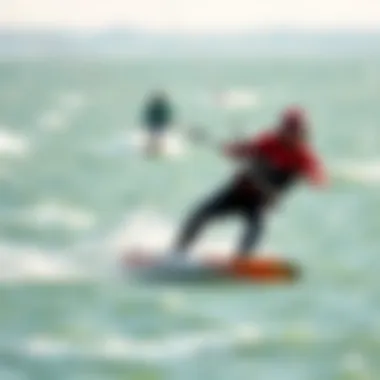
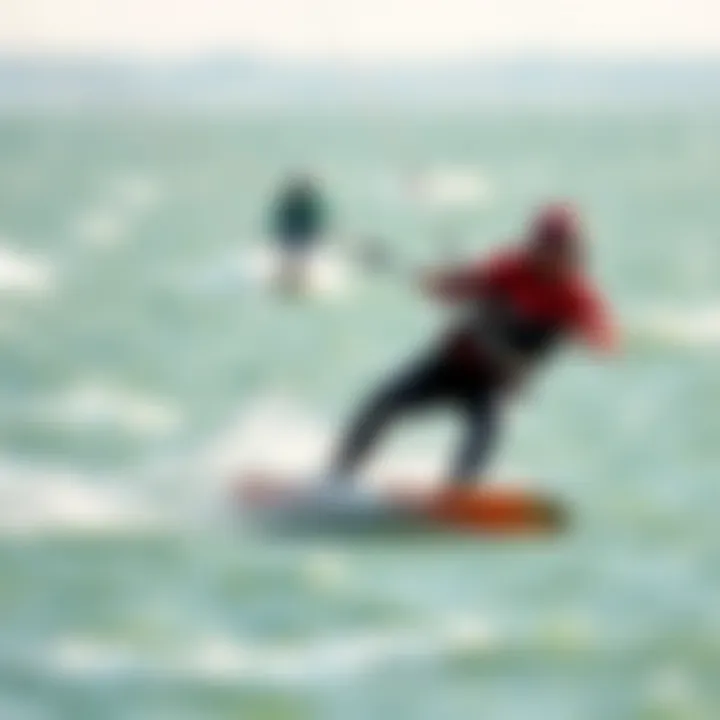
A snug fit is the foundation of a successful wetsuit experience. When the wetsuit conforms closely to your body, it reduces the amount of water that can enter and circulate within the suit. This trait is particularly vital in winter conditions, where maintaining body heat becomes crucial. Observing how the wetsuit contours to your body offers substantial benefits, such as:
- Increased Thermal Retention: A tighter fit minimizes water flow, which in turn helps in retaining the warmth generated by your body.
- Enhanced Mobility: A fitted wetsuit allows for more freedom of movement. This is especially important when you maneuver your board, perform tricks, or paddle through waves.
- Improved Performance: A well-fitted suit can result in better hydrodynamics. Think of it like a second skin—there’s less drag in the water, allowing for more speed and control.
However, it’s essential that the snugness does not translate into discomfort. Excessively tight areas, especially around the neck or armpits, can become a source of irritation, distracting you from enjoying your ride.
Common Sizing Mistakes to Avoid
When it comes to selecting the right wetsuit size, many kiteboarders fall into the trap of common pitfalls. Avoiding these mistakes can mean the difference between a pleasant experience and a torturous one:
- Ignoring Size Charts: Each brand can differ in their sizing. Always refer to the specific brand's size chart. Taking accurate measurements of your chest, waist, and inseam can lead to a better-fitting suit.
- Overlooking Body Shape: People come in all shapes and sizes. Just because a wetsuit fits snugly in one area, doesn’t mean it will fit well overall. Recognizing your body type (e.g., athletic, tall, curvy) can guide you to suitable options.
- Failing To Account for Layers: Consider what you might wear beneath the wetsuit, such as rash guards or thermal tops. If you plan to layer, size up slightly; otherwise, you might sacrifice comfort and movement.
- Avoiding Trials: If possible, trying on wetsuits before purchase is invaluable. Pay attention to how it feels when you bend, twist, or squat. If it feels restrictive at any point, pick another size.
"Finding the right fit is not just about comfort; it's also about enhancing performance on the water."
Choosing a well-fitting wetsuit is an investment in your comfort and performance. The combination of a snug fit and attention to sizing details can significantly elevate your kiteboarding adventures, especially in the chilly waters of winter.
Wetsuit Care and Maintenance
A wetsuit is an investment that goes beyond a mere piece of gear; it is your shield against the icy grip of winter waters. Maintaining your wetsuit properly not only prolongs its lifespan but also ensures it performs at its best when you hit the waves. The importance of wetsuit care cannot be overstated, especially for kiteboarders who depend on this equipment for comfort and safety in cold conditions.
Cleaning Techniques for Longevity
To keep your wetsuit in pristine condition, a few cleaning practices should be carried out regularly. Here’s a straightforward method:
- Rinse Immediately: After each kiteboarding session, rinse your wetsuit in clean, cold water. This step is crucial to remove salt, sand, and other debris that can wear on the neoprene over time.
- Use Mild Soap: When your wetsuit needs a deeper clean, use a gentle wetsuit-specific soap or a mild detergent. Avoid harsh chemicals that might degrade the material.
- Soak for a While: To tackle stubborn stains, soak the wetsuit in a bath mixed with water and soap for around 30 minutes. Gently scrub any tough spots with your hands or a soft sponge.
- Air Dry: Hang the wetsuit inside out, away from direct sunlight. UV rays can deteriorate neoprene. Make sure it’s completely dry before storing it to prevent mildew.
Proper upkeep can extend the life of your wetsuit, giving you many more adventures on the water.
Storage Best Practices
Proper storage is just as important as cleaning. Here are several recommendations to keep your wetsuit in tip-top shape:
- Avoid Folding: Never fold your wetsuit, as creasing can damage the material over time. Instead, roll it up gently to store it in a compact way.
- Hang with Care: Use a wide hanger to suspend your wetsuit. This method helps maintain the shape and prevents stretching of the shoulders.
- Cool, Dry Place: Store your wetsuit in a cool and dry location, out of direct sunlight, to avoid heat exposure that might warp the neoprene.
- Ventilation: Ensure that the storage area allows for airflow. A stuffy environment can lead to odors and promote mold growth.
Following these cleaning and storage practices will not only keep your wetsuit functional but also ensure that it remains a reliable companion during your winter kiteboarding adventures. Regular maintenance may seem like a hassle, but it pays off when you’re comfortably carving through the chilly waters, confident in your gear.
Choosing the Right Accessories
Selecting the right accessories is a vital aspect of kiteboarding during winter months. While a well-fitted wetsuit provides much of the warmth and protection you need, accessories like boots, gloves, and hoods can significantly enhance your overall experience. They not only improve comfort but also ensure better performance on the water when temperatures drop. Finding the right accessories requires understanding their specific functions and how they contribute to a safer kiteboarding adventure.
Boots and Gloves: Essential for Cold Weather
When you venture out into frigid waters, protecting your extremities becomes paramount. Boots and gloves serve as your first line of defense against the cold.
Boots are designed to keep your feet warm while providing sufficient grip and protection. Many kiteboarders opt for 5mm boots, which offer that extra insulation on super chilly days. Here are a few features to look for in quality boots:
- Neoprene Composition: A thicker neoprene not only provides warmth but also protects against cuts and abrasions. Look for models with additional reinforcements on the sole.
- Fit: A snug fit is crucial. Boots that fit too loosely can allow cold water to sip in, negating their warming properties.
- Traction: Soles with non-slip surfaces help maintain grip, which is vital when boarding or walking on slippery rocks.
Gloves, on the other hand, are essential for maintaining dexterity in your hands while offering warmth. A 3mm to 5mm thickness is generally sufficient for winter riding. Consider these points when choosing gloves:
- Fingertip Sensitivity: Look for gloves with a design that allows for better sensitivity and grip, ensuring that you can operate your gear effectively even in the cold.
- Seal Quality: Sealed seams ensure less water enters the glove, keeping your hands warmer.
Tip: Try your boots and gloves on together while wearing a wetsuit to ensure a proper fit. A good combination makes a world of difference during your sessions.
Hoods: Keeping Your Head Warm
A significant amount of body heat escapes from the head. Hence, a well-fitting hood is often overlooked but immensely important. In fact, many experienced kiteboarders swear by them. Hoods can come in various thicknesses, but 3mm to 5mm is typically the standard.
- Design: Look for hoods that cover ears fully while having a flexible face opening. This allows for comfort while keeping water out.
- Fit and Seal: A proper fit ensures that there are no gaps for cold water to seep in; it also prevents wind chill. Hoods often come with a strap or an adjustable chin section to secure them.
- Material: Choosing a hood made from high-quality neoprene not only provides insulation but also adds durability. Many models also feature thermal lining for extra warmth.
In winter kiteboarding, every accessory counts. A well-constructed wetsuit alongside the right accessories can make your sessions warm, safe, and enjoyable. Remember, small details often leave a big impact, and investing in quality gear will pay dividends in comfort and performance.
Environmental Considerations
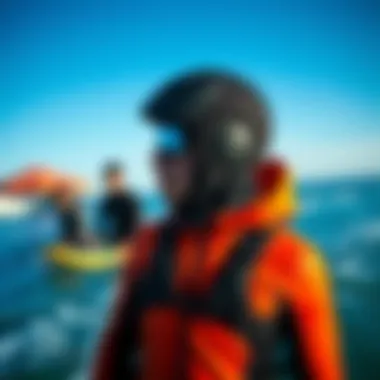
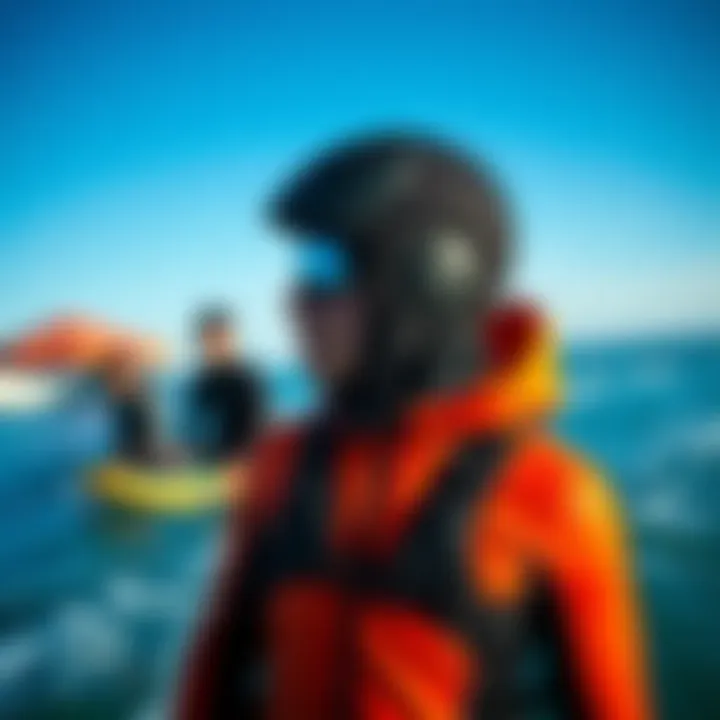
When discussing winter wetsuit thickness, it's crucial to also consider the environmental impact of our choices. The products we use, including wetsuits, can have a significant footprint, and being mindful of these factors can make a difference. In this section, we’ll explore two key areas: the materials that make up our wetsuits and the eco-friendly practices kiteboarders can adopt.
Sustainable Wetsuit Materials
Selecting wetsuits made from sustainable materials not only benefits the environment but can also enhance performance.
Many traditional wetsuits are made from neoprene, a synthetic rubber derived from petroleum, which poses significant environmental concerns. In contrast, brands are now producing wetsuits from natural rubber or recycled materials. For instance, some wetsuits utilize Yulex, a plant-based alternative that reduces dependence on fossil fuels. This kind of material is not only eco-friendlier but has been known to offer comparable insulation properties to traditional options.
Here’s a list of some sustainable materials you might find in modern wetsuits:
- Natural Rubber: Sourced from rubber trees, it's a renewable resource.
- Recycled Neoprene: This repurposes old wetsuits and reduces waste.
- Bio-based Wetsuits: Incorporating materials like algae or oyster shells, these innovations highlight the power of nature in creating performance gear.
Using these materials can contribute to a more sustainable kiteboarding experience while still providing warmth and flexibility.
Eco-Friendly Practices for Kiteboarders
As kiteboarders, we also have a responsibility to practice environmental stewardship. It’s not just about the gear we choose but how we use and care for that gear.
Here are some eco-friendly practices every kiteboarder should consider:
- Proper Disposal of Wetsuits: Once a wetsuit has reached the end of its life, avoid throwing it in the landfill. Brands often have recycling programs to repurpose old wetsuits.
- Use Eco-Friendly Cleaning Products: Traditional detergents can be harmful to aquatic life. Opt for biodegradable soaps when cleaning your wetsuit.
- Choose Local: When purchasing new gear, consider local brands that are committed to sustainable practices.
- Reduce Travel Impact: Carpooling to kiteboarding spots or using public transport can help minimize your carbon footprint.
Practicing eco-friendly habits can help ensure that our beloved kiteboarding spots remain pristine for future generations.
By integrating the use of sustainable materials and engaging in eco-friendly practices, the kiteboarding community can lessen its impact on the environment. This holistic approach is not just beneficial but necessary for preserving the natural beauty that attracts us to the sport in the first place.
For more comprehensive insights into sustainable practices in sports, you can refer to resources like National Geographic and explore further initiatives at Surfrider Foundation.
In summary, while choosing the right wetsuit thickness is essential for comfort and performance, it’s equally important to think about the ecological implications of our choices. Let's make informed, responsible decisions that reflect not only our passion for kiteboarding but also our commitment to the planet.
Expert Recommendations
When it comes to selecting the right winter wetsuit, the insights of seasoned kiteboarders can be invaluable. These professionals often spend countless hours on the water, exposing themselves to the extremes that winter conditions can bring. Their feedback helps streamline the process of finding a wetsuit that not only meets the technical requirements for warmth and flexibility but also enhances overall performance.
Feedback from Professional Kiteboarders
Professional kiteboarders have unique insights that stem from firsthand experiences. They share perspectives that can sometimes differ from marketing claims. Many emphasize the significance of wetsuit thickness relative to water temperature—specifically, how it can either enhance or hinder your performance. A common consensus among them is recognizing the specific conditions they frequently encounter.
"Choosing the right wetsuit thickness has been a game changer for me. Too thick, and I lose mobility; too thin, and I freeze!" – Experienced Kiteboarder
- Warmth vs. Flexibility: Feedback often highlights the trade-off between necessary warmth and maintaining the ability to maneuver effectively. Many professionals recommend a 4/3mm wetsuit for colder conditions as a sweet spot where warmth and flexibility meet.
- Layering Options: Some experts advocate for layering with accessories like vests or additional base layers for those truly frigid days. This approach allows for adjustments based on varying conditions.
- Quality Over Price: Many also stress that investing in higher-quality materials and construction pays off in durability and performance, especially for avid kiteboarders who often ride in colder waters.
Aligning Gear with Skill Levels
Matching gear to skill level can greatly impact a kiteboarder's effectiveness on the water. Some pro riders may prefer a slightly thicker suit, believing it offers better insulation, while beginners might need a wetsuit that balances warmth with ease of movement.
- Beginners: For novices, starting with a 3/2mm wetsuit is often suggested as it provides ample warmth with enough flexibility to ensure ease of learning. A more flexible suit can help new riders focus on mastering techniques without feeling hindered by their gear.
- Intermediate Riders: Those with some experience might consider a 4/3mm suit. This option addresses the need for additional warmth while ensuring they can continue honing their skills without feeling restricted.
- Advanced Kiteboarders: More advanced kiteboarders, who push their limits in colder climates, may opt for a 5/4mm suit during the harshest conditions. However, they also know that their choice in thickness should not compromise agility.
When choosing a wetsuit, it's essential to also think about the type of riding one plans to do and the expected water conditions.
By analyzing advice from professionals, kiteboarders can align their gear choices with their expertise and comfort levels, ultimately creating a more enjoyable and safer riding experience during colder months.
Culmination: Making Informed Choices
In the realm of kiteboarding, particularly during the colder months, understanding the ins and outs of wetsuit thickness emerges as pivotal for enhancing both performance and comfort on the water. Choosing the right wetsuit isn't merely a matter of personal preference; it’s a decision that affects safety and enjoyment while engaging with the elements. The overarching goal of this article has been to arm you with the knowledge needed to make informed choices when it comes to selecting the ideal winter wetsuit.
The Intersection of Comfort and Performance
When we talk about comfort in kiteboarding, we aren’t just mentioning the feel of the suit against the skin, but rather how well it manages heat retention while allowing for movement through the water. A snug fit contributes to reducing water ingress, ensuring that the individual remains warm, even in frigid conditions. However, while maintaining warmth is crucial, performance remains absolutely vital. A wetsuit that feels like a second skin can significantly boost agility and responsiveness, allowing kiteboarders to maneuver seamlessly in challenging waters.
- Flexibility vs. Insulation: A balance must be struck between flexibility and thermal protection. Thin suits may offer superior mobility, but when the temperatures plummet, thicker suits are often necessary to retain core body heat.
- Material Composition: Innovation in wetsuit fabrics, such as the advent of limestone neoprene, presents a fabric that is lighter yet offers comparable warmth, allowing for a broader range of movement and reducing fatigue.
It's essential that each rider understands their personal preferences and how these affect their overall experience on the waves. A wetsuit that works wonders for one individual may feel constricting or overly bulky to another.
Future Trends in Wetsuit Technology
The future of wetsuit design is shaping up to be as exciting as it is innovative. Advances in technology are likely to bring about suits that enhance performance while providing thermal benefits that exceed current standards. For example, seamless construction techniques are reducing water seepage and enhancing flexibility, moving towards an almost second-skin fit.
- Eco-Friendly Materials: As awareness of environmental issues grows, manufacturers are increasingly exploring biodegradable materials that also meet the thermal needs of users. This shift not only appeals to an environmentally conscious market but also pushes the industry towards sustainability.
- Smart Wetsuits: Concepts are already being developed where integrated sensors could monitor body temperature and adjust insulation levels accordingly. These smart wetsuits could revolutionize how kiteboarders interact with their equipment.
- 3D Printing: Some companies are looking into the potential of 3D printed wetsuits, offering tailor-made solutions that fit the unique contours of individual bodies, maximizing comfort and minimizing water entry.















